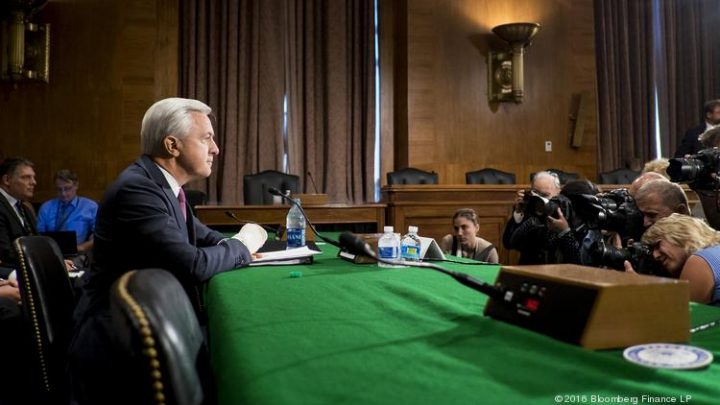The Wells Fargo debacle is a perfect example of a toxic culture gone wild.
In the maddening pursuit of phantom profits, the company directed employees to open more than 2 million bogus accounts — accounts that people never asked for, and in some cases, weren’t even aware had been opened.
If you’re a CEO, don’t wait until disaster strikes before you do a values check-up. Pictured is John Stumpf, chief executive officer of Wells Fargo.
Pete Marovich: Bloomberg
And now the stock has suffered, the CEO may get sacked, and Congress may very well impose more regulations on an already over-regulated industry.
Two of Wells Fargo’s key values are “ethics” and “what’s right for customers.”
Huh?
How could a company with those values possibly do what was clearly unethical and wrong for customers? The answer is, it couldn’t.
Wells Fargo’s values of “ethics” and “what’s right for customers” are only what I call bumper sticker values. The real values that lie beneath the slogans are vastly different.
This is not unusual. There is often a difference between bumper sticker slogans and the real values that lie beneath.
The values that lie beneath
Value statements are always warm and fuzzy. But a company’s real values are manifested by how they act, not how they claim they act. Such is the case with Wells Fargo. How they acted speaks volumes about the values that lie beneath.
Was this the act of a few rogue employees that ignored Wells Fargo’s values? I don’t think so, considering 5,300 employees were fired for opening the ghost accounts. Even given the size of Wells Fargo, that is more than a few rogue employees.
That tells me that one of Wells Fargo’s underlying values is profit above all else. But I don’t see that in the bumper sticker values.
Don’t get me wrong, profit matters. But if you put that above all else, people will act that way. And bad things will happen. Quality will suffer, relationships among employees and customers will suffer, and ultimately the business is doomed.
Cultures are formed and maintained by the shared values that lie beneath, not the bumper sticker values. Chances are the Wells Fargo CEO had no idea an underlying set of values existed that was vastly different than the bumper sticker. And because he didn’t know, he couldn’t do anything about it. And now disaster has struck and it’s too late.
Do a values check-up
If you’re a CEO, don’t wait until disaster strikes before you do a values check-up. But don’t have the human resources people ask employees what the company values are. Don’t declare what you think the values are and expect people to behave accordingly. That never works.
Here is what you should and shouldn’t do:
Do not make this an exercise for the human resource department. If it is to be taken seriously, it has to come right from the top. People need to know that values matter.
Have an outside professional survey company conduct an anonymous survey and ask every single employee in complete confidence what they think the company values are. You may be astounded by the results.
If the underlying values are not the same as the bumper sticker, find out why. What is driving the difference? Chances are you’ll find operating managers are the root cause. Or you might be the root cause. As an example, many operating managers don’t give a hoot about anything other than results. Of course, results matter. No company can prosper without positive results. But results without appropriate values are often temporary, or in the case of Wells, only illusory.
Reality check time. Does your company have the “right” values? By that I mean values that serve your employees, customers, community, and shareholders equally. Values that form what I call a “culture by design, not default.” If not, it’s time to change them.
Let’s assume you have the “right” values. Start at the top and go layer by layer. Those that don’t believe in, won’t abide by, or demonstrate the values have to go. This sounds simple, but it is not easy. But it is essential. If your top managers ignore the values, everyone else will. This is a multi-year process that you must undertake carefully and delicately, otherwise the business will crash and burn. Take it one step at a time, one manager at a time. Once you start replacing managers for values reasons, the whole organization will begin to behave differently. People will applaud you for doing so.
Don’t let anybody in the front door that doesn’t fit in with your values. Interview potential new employees with values in mind. Don’t just state the values and ask if they agree. Of course they will agree, they want the job. Ask them what their values are. Ask them what values they would admire in a company. If their values don’t match with company values, don’t hire them, no matter how good they are. Otherwise, they will be like an infectious disease in the organization.
And finally, make values a key part of performance evaluation. Don’t make this a check-off-the-box exercise. Make values the standard for promotions and compensation increases. And make values a key determinate in terminations.
This article was originally published in The Business Journals.
